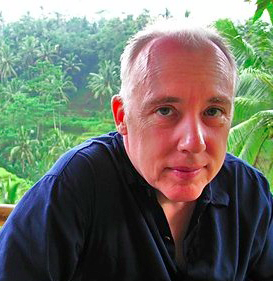 Donald Favareau is an Associate Professor at the University Scholars Programme, National University of Singapore, where he developed and has been teaching since 2004 Asia’s first university-level course on Biosemiotics. Co-Founder and Vice-President of the International Society for Biosemiotic Studies since 2005, his work explores both the natural foundation of sign processes in living systems, as well as the history of scientific thinking about such processes.
Donald Favareau is an Associate Professor at the University Scholars Programme, National University of Singapore, where he developed and has been teaching since 2004 Asia’s first university-level course on Biosemiotics. Co-Founder and Vice-President of the International Society for Biosemiotic Studies since 2005, his work explores both the natural foundation of sign processes in living systems, as well as the history of scientific thinking about such processes.
Having graduated from UCLA with a PhD in Applied Linguistics with an emphasis on both Interaction Studies and the Neurobiology of Language, and a BA and an MA, both also from UCLA, in Philosophy of Mind, he is the author and editor of the world’s first textbook anthology on biosemiotics, Essential Readings in Biosemiotics: Anthology and Commentary (2010), as well as the collected volumes A More Developed Sign: Interpreting the Work of Jesper Hoffmeyer (2016), Co-operative Engagements in Intertwined Semiosis: Essays in Honour of Charles Goodwin (2018), and Knowing Nature in the Language of Biology and Semiotics (2022). His own writings have appeared in journals such Biosemiotics, Sign Systems Studies, Philosophy, The Journal of the American Psychoanalytic Association, Semiotica, Issues in Applied Linguistics and Progress in Biophysics and Molecular Biology, as well as a number of edited book volumes on Biosemiotics.
Seeking to join the insights and concepts of embodied, distributed, and mutually-constructed, moment-to-moment joint cognition with the analyses of pre-linguistic, organismic meaning-making that is the central purview of Biosemiotics, Favareau has been central member of the Biosemiotics community since its first international conference in 2001, and is the subject of the 2017 festschrift Biosemiotics in the Community: Essays in Honour of Donald Favareau.
He is also a dedicated teacher and developer of a number of highly regarded interdisciplinary courses at the National University of Singapore’s University Scholars Programme, including Multidisciplinary Perspectives on ‘Mind’, Biosemiotics: Signs in Nature and The Doors of Perception: Biology, Technology and Culture, and is currently working on the creation of feature-length video documentary that will not only detail the history of the interdisciplinary research agenda of Biosemiotics, but that will, in so doing, also provide newcomers with an understanding of both the history and the concepts that inform that field.
